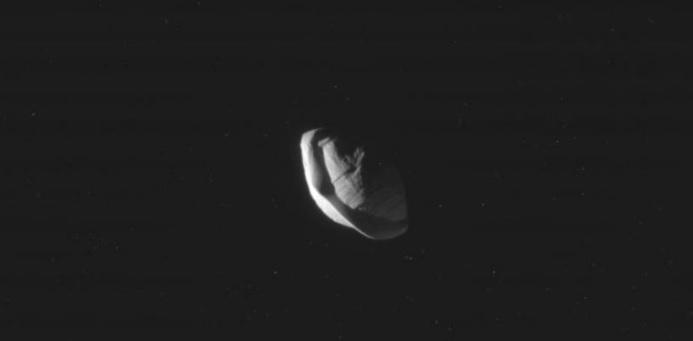
Saturn’s Ring : tiniest Moon looks like a space ravioli
Out of Saturn’s 53 confirmed Moons, the Moo named as Pan has a distorted shape. The new picture by NASA confirms its shape.
Long ago astronomers found out that Saturn has a tiny Moon which looks like a distorted walnut or pasta. Different pictures were taken to research the distorted shape of this Moon. Astronomers named this Moon, Pan, which is one of the tiniest Moon that Saturn possess. A recent picture of Pan has confirmed that it looks like an empanada or a space ravioli. It is a bulging ring-like structure at its outer portion. It is white in colour and revolves around Saturn’s ring. Pan tends to attract objects from Saturn’s ring, and hence astronomers are of the opinion that the bulging ring-like structure of Pan is due to its nature of drawing objects from Saturn.
Recently NASA’s Cassini probe captured a picture of Pan which revealed a lot of features about its nature and existence. The image was taken by Cassini Probe and sent back to NASA on Thursday which depicts that Saturn’s tiny moon Pan which is a distinctively ridged satellite is so close to the planet, that it completes a full orbit roughly every 14 hours. The moon, which has a diameter of just about 20 miles (35 kilometres), follows in the footsteps of its ancient Greek namesake by acting as a shepherd to the material that makes up Saturn’s rings, clearing and space in their midst the place known as the Encke Gap.
Astronomers are assuming that due to Pan’s attracting property it has developed a bulging and restored shape. But no confirmation regarding its shape has been provided it. Scientists are of the opinion that finding out Pan’s history behind its distorted shape will take a while since it’s hard to find why Pan consists of attracting features. They are also not sure yet if Pan consists of drawing power of objects from Saturn’s ring.
While talking to some scientists, one of them quoted, “We propose that Pan and Atlas ridges are kilometers-thick ‘ring-particle piles’ formed after the satellites themselves and after the flattening of the rings but before the complete depletion of ring material from their surroundings.”
“I saw this picture, and I thought, that’s an artist’s conception,” said Carolyn C. Porco, leader of Cassini’s imaging team and the visiting scholar at the University of California, Berkeley, tells the New York Times. “Then I realised it was real.”
This picture may be the last image taken by Cassini Probe.


